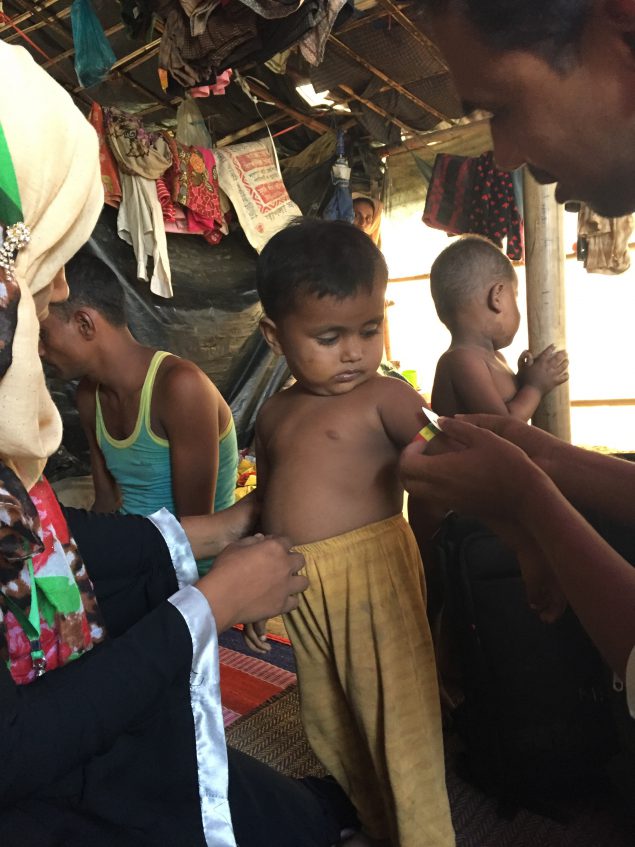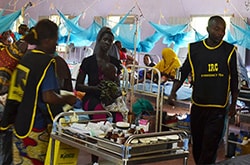CDC Promotes and Improves the Health of Refugees Every Day

CDC experts work with Action Against Hunger survey team members measuring mid-upper arm circumference for a nutrition assessment of Rohingya refugees in Nayapara refugee camp, Cox’s Bazar, Bangladesh. Nov 2017
Photo credit: Aimee Summers/CDC
June 20th is World Refugee Day. First observed in 2001, it commemorates the 50th anniversary of what was originally known as Africa Refugee Day. Today, it honors the courage and resilience of the world’s refugees.
CDC’s Role in Refugee Health
CDC partners with agencies, governments, and organizations to promote and improve the health of immigrants, US-bound refugees, and migrants globally. CDC’s Division of Global Migration Health (DGMH) oversees the required medical examination of refugee and immigrant visa applicants, and promotes preventive treatments for and vaccination of refugees for several communicable diseases before departure to the United States.
Refugees may not be fully protected against certain infectious diseases due to lack of access to national vaccination services. For years, outbreaks of vaccine-preventable diseases, such as measles and polio, impacted the refugee resettlement process leading to long travel delays and disease spread. These outbreaks often caused a halt in the resettlement process until spread of disease in the refugee population was controlled. Since 2013, CDC has partnered with the Department of State Bureau of Populations, Refugees, and Migration (PRM) and the International Organization for Migration (IOM) to implement a vaccination program for US-bound refugees overseas before resettlement. Since then, more than 400,000 refugees have received vaccinations, preventing outbreaks that can cause illness as well as delays in resettlement. Additionally, DGMH’s field programs in Nairobi, Kenya, and Bangkok, Thailand work within their regions to improve their ability to detect and to reduce spread of diseases in refugee camps. CDC also works with experts in refugee health to provide guidance for the domestic refugee medical examination recommended once newly arrived refugees reach their final destinations.
Public Health Emergency Response
When CDC activated its emergency response to the COVID-19 pandemic, CDC worked to protect the health of travelers and reduce the risk of spreading the disease associated with rapid global travel. CDC developed communication materials tailored to refugee, immigrants, and migrant (RIM) communities in the United States and engaged with partners and organizations working in those communities to disseminate these culturally appropriate materials.
Following the fall of Kabul, the United States evacuated more than 70,000 Afghans to “Safe Havens” (military bases and a hotel convention center) in the United States as part of Operation Allies Welcome. At these Safe Havens, CDC provided oversight and medical support to Afghans receiving COVID-19 testing and the required medical examination for immigration, which included vaccinations. CDC also worked to ensure that information from the medical examinations was routed to receiving health departments at the Afghans’ final destinations to ensure proper follow-up of certain conditions, such as tuberculosis. This also ensured continuity of care for the recommended domestic refugee medical examination. Additionally, CDC provided several resources in multiple languages to Afghans, as well as resources to partners and guidance to laboratories assisting with Operation Allies Welcome.

The U.S. government works with the International Rescue Committee in Kakuma Refugee Camp, Kenya to provide health care to refugees and the Turkana host community.
© US Embassy Nairobi/K. Alderman
Partnerships Ensuring Continuum of Care
After arrival, refugees receive assistance with housing and healthcare coverage for 12 months. CDC continues to work with partners to develop and distribute health education and communication materials that are culturally and linguistically appropriate for refugees. CDC funds The National Resource Center for Refugees, Immigrants, and Migrants (NRC-RIM), which supports health departments and community organizations working with RIM communities. Since 2020, NRC-RIM launched several health communication products translated in as many as 44 languages. Through partnerships, refugees connect with domestic resources to ensure a continuum of care enabling them to live healthy, active, and productive lives in their new communities.
- Immigrant and Refugee Health fact sheet – Learn more about the Immigrant and Refugee Health Branch, what we do, where we work, and more.
- The Long Road to America – One Refugee’s Experience – Read a firsthand account of the challenges faced by refugees.